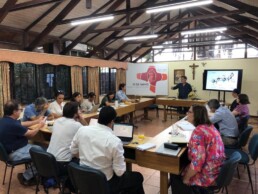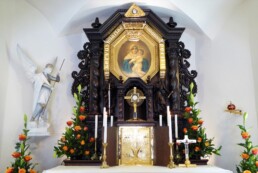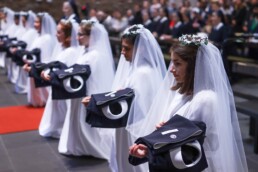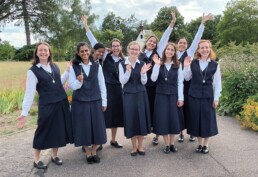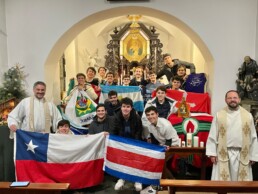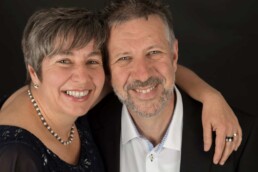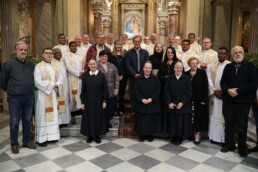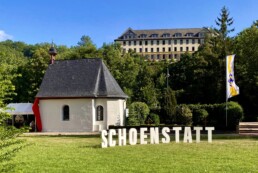May 31st Jubilee: What is the progress on the preparations?
Interview with Fr. Gonzalo Illanes Fuertes, national director of the Schoenstatt Movement in Chile:
Registrations have already entered the waiting list phase. How many people have registered and from which countries? Why is it necessary to limit the number?
We currently have a total of 1400 people registered, many of whom are pilgrims from outside of Chile. There are about 300 people coming from Brazil, Argentina, United States, Germany, Ecuador, Paraguay. For us it has been a great joy to have full registration with over a month to go before the Jubilee. Unfortunately, we had to limit the number of participants for logistical reasons since the space in Bellavista does not allow us to accommodate more pilgrims.
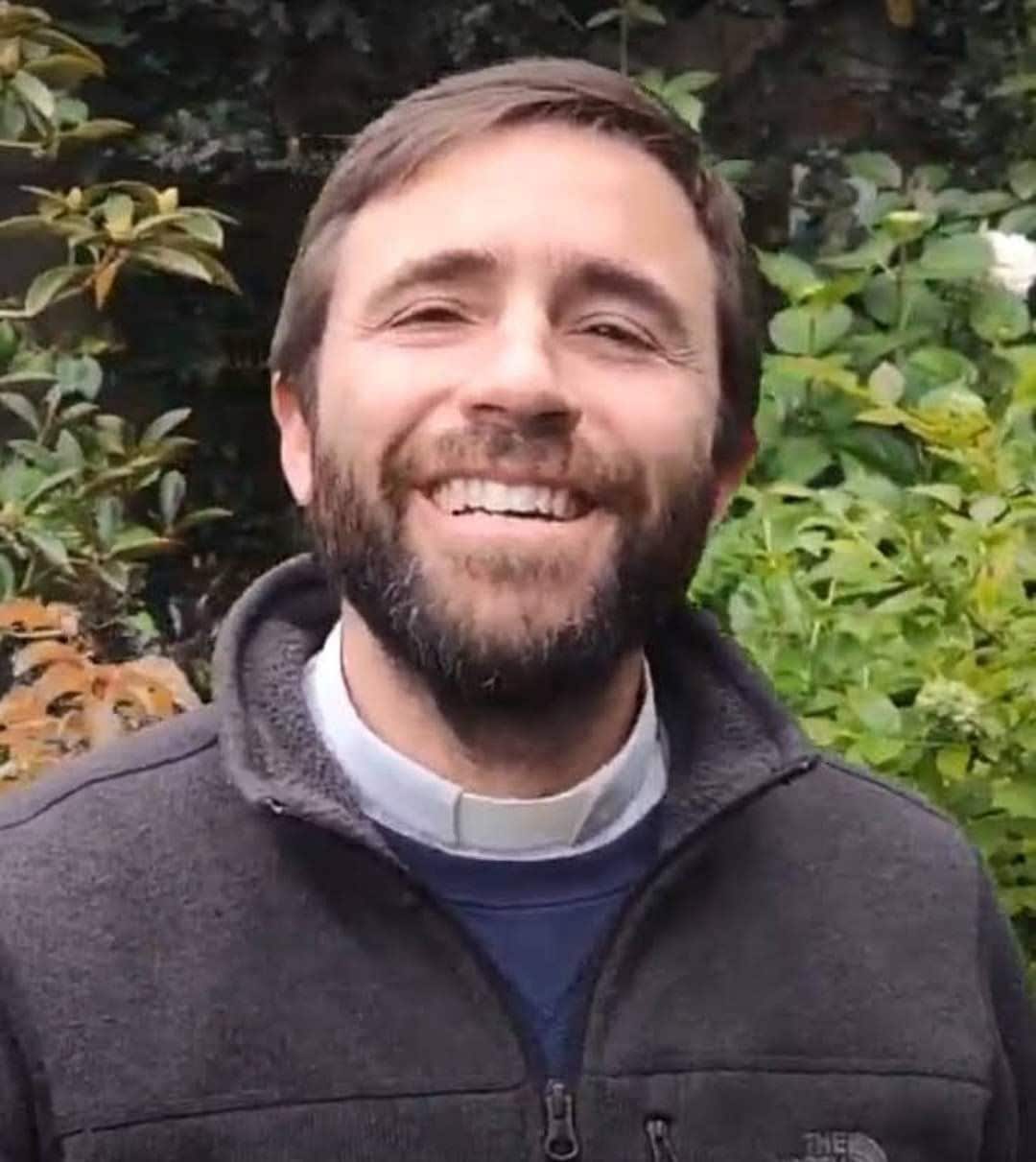
What are the main objectives of this Jubilee?
The objectives of the Jubilee are:
- to go on pilgrimage together;
- to open our hearts;
- and to renew our Covenant of Love with the Blessed Mother.
On May 31st, we want to go on pilgrimage to the Shrine of Bellavista, but also to all the Shrines of the world, to thank Mary for teaching us from there to follow Jesus Christ and to encounter God in each person. We also want, during these Jubilee days, to gather as an International Family, opening our hearts to the Spirit and asking Him to enlighten us and help us to better understand both our history and our present. In short, we want to renew our Covenant of Love with the Blessed Mother and thus celebrate together this milestone in our history. We will ask the Blessed Mother to grant us the gift of renewing our enthusiasm for the mission that Schoenstatt has for our times.
Where are we in the preparation for the Jubilee celebrations and how is the Schoenstatt Family participating in this process?
The preparation is well underway. We have commissions composed of members of the different branches, federations, and institutes of the Schoenstatt Family at the national level. We have also been in permanent dialogue with representatives of the Movement from different communities at the international level.
It has been a gift to see how the symbol of the jubilee is present in the most diverse Shrines of the world and how they are praying for this celebration. We are very happy to see that there is an atmosphere of celebration of the 31st of May that has been spreading throughout the international Schoenstatt. For example, we have been sharing reflection topics and online interviews that are being very well received and disseminated.
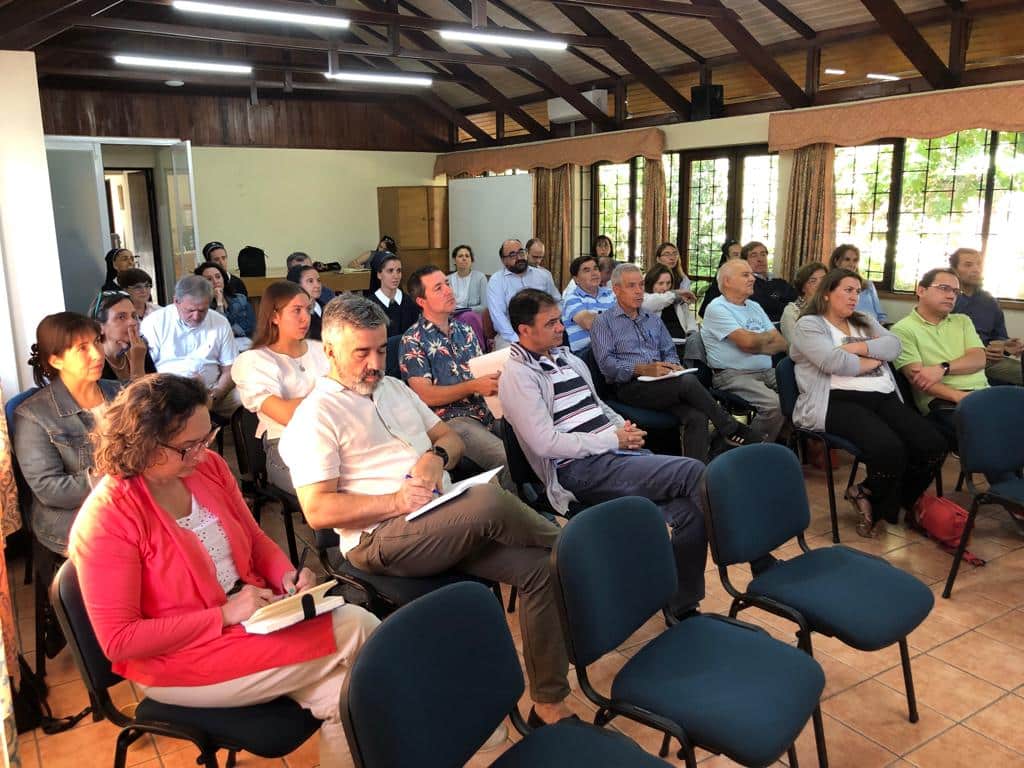
What can pilgrims expect from this pilgrimage?
The first thing that we would like a pilgrim who comes to Bellavista to experience is that these are days of festivities, of celebration of the charism, of rejoicing for the Covenant and for the mission that has been entrusted to us. We want to encourage the pilgrims to strengthen bonds of friendship and establish ties with people they may not have known before. In a global sense, we want it to be a great family experience, where we can feel that we are on the way "in each other" towards the heart of God and of the Blessed Mother.
As for the more concrete experience, we want to share with you that during the Jubilee we want to give special emphasis to spirituality and religious experience: Mass will be offered on the three days of the Jubilee, with a special focus on the Mass of May 31st, as it is the day of the milestone, and on the final Mass of June 2nd, during which the new Unity Cross will be enthroned and presented as a gift to Bellavista. Also, after each Mass there will be prayers and moments of spirituality around the Cenacle Shrine.
As for the agenda, we want to address the different topics through panels with guests who will speak based on their different areas of expertise. We will talk about the context, the message, and the projection of the May 31st milestone. We also wanted to offer the possibility of having workshops, in which pilgrims will be divided into interest groups to share in a more specific way on the topics that concern them.
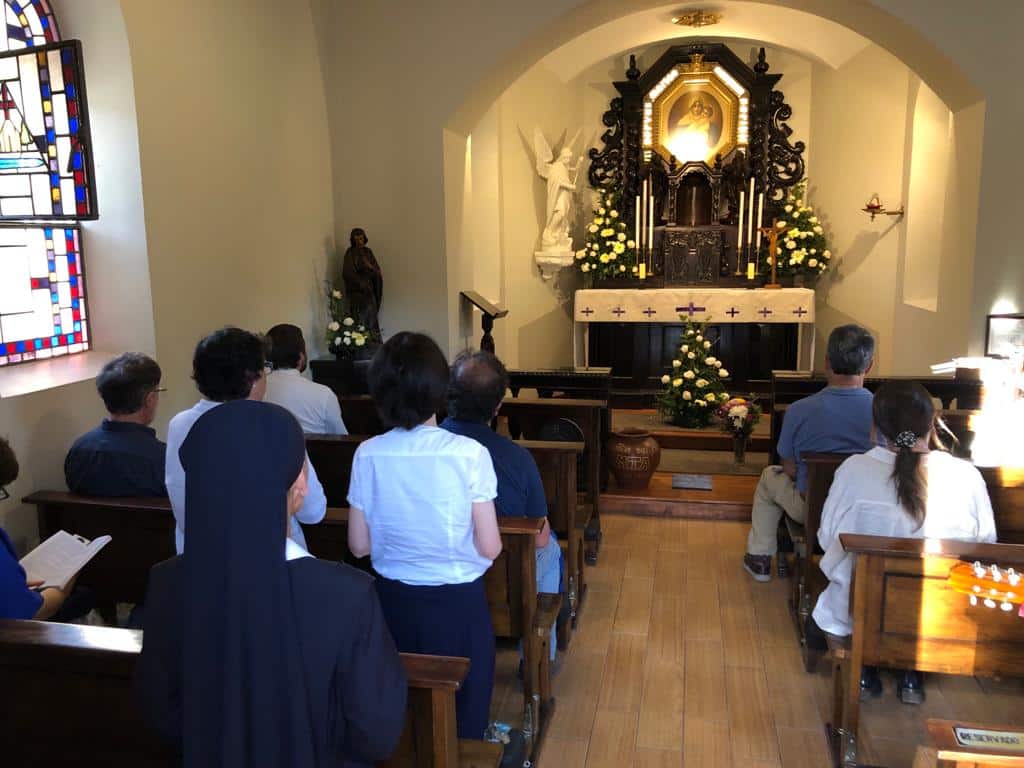
Will people who do not go to Bellavista in person be able to participate in some way? Will there be some kind of live broadcast?
All Schoenstatters throughout the world are summoned to celebrate the 75th Anniversary of May 31st. And we are called to celebrate, in the first place, in person. That is why we are "campaigning" so that each Shrine, Wayside Shrine or local Schoenstatt Family will gather on May 31st to have a Mass or liturgy of "gratitude for the third milestone".
We also want to invite Schoenstatters from all over the world to join the live transmissions that we will broadcast from almost every part of the Jubilee. Except for a few blocks, the entire Jubilee will be streamed on YouTube. So, Friday, May 31st, Saturday, June 1st and Sunday, June 2nd, you will be able to connect with the live streaming and join the Jubilee celebration. All the links can be found on the jubilee website at jubileo31demayo.schoenstatt.cl and will be transmitted through the YouTube account of Schoenstatt Chile.
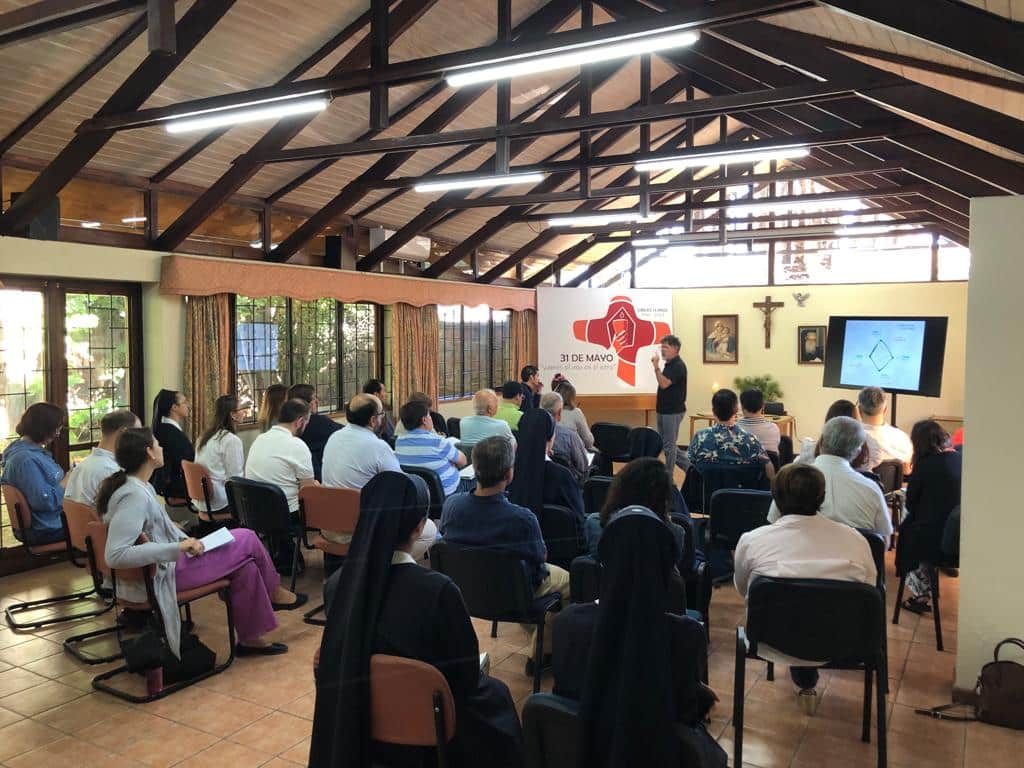
What is your special wish for this Jubilee?
I would like that during this Jubilee the Blessed Mother would grant us the gift of being able to assume our Covenant mission with new strength and creativity, that she teaches us how to vitally unite the natural with the supernatural, the profound communion of man with God. I would also like there to be a current of gratitude and sending forth in our entire international family, taking this celebration as an opportunity to relive together this charism for which Father Kentenich risked everything.
The Original Shrine joins Pope Francis in the "24 hours for the Lord"
For the last 10 years, at the initiative of Pope Francis, the day of prayer called "24 hours for the Lord" has been taking place during Lent. This day is held all over the world, especially on the Friday/Saturday before the fourth Sunday of Lent. In 2024, the event will take place from March 8th to 9th.
The motto chosen by Pope Francis for this year's event is: "Let us lead a new life" (Rom 6:4). According to Archbishop Rino Fisichella, Pro-Prefect of the Dicastery for Evangelization, "the aim of the event is to put the sacrament of reconciliation back at the center of the pastoral life of the Church, of all ecclesial realities. This is the center of the Gospel message: the mercy of God, which gives us the certainty that before the Lord no one will find a judge, but rather a father who welcomes him, consoles him and also shows him the path of renewal."
The dicastery also offers an aid for the day of prayer - download here the text in English.
Adoration of the Blessed Sacrament initiatives are taking place all over the world and, in a special way, the Church offers the possibility of receiving the sacrament of Reconciliation to many who wish to do so.
The "24 Hours for the Lord" in the Original Shrine in Schoenstatt
This year, the motto of the "24 Hours" at the Original Shrine in Schoenstatt will be: "His present - our future". They will begin on Friday, March 8 at 6:00 p.m. (local Schoenstatt time) and will end on Saturday, March 9 at 6:00 p.m.
There will be times of adoration, music and prayers in different languages, silent prayer, meditations, etc. There will also be an opportunity for confession for those who can participate in person.
Those who follow from a distance will be able to pray from home via webcam, click on the link below:
Program at the Original Shrine
Friday, March 8th
6:00 p.m. - Angelus and opening prayer
7:00 p.m. - Rosary (in German)
7:45 p.m. - Evening Blessing
8:00 p.m. - Time for group adoration
10:00 p.m. - Silent AdorationSaturday, March 9th
6.30 a.m. Holy Mass (in German)
8.00 a.m. Holy Mass (in German)
9.30 a.m. Holy Mass (in German)
10.30 a.m. Silent Adoration
11.00 General Adoration (in German)
12.00 Angelus followed by silent adoration
1:15 p.m. Devotional
2:00 p.m. Time for community adoration (in English)
3:00 p.m. Liturgy of the Hours with the Adoration Sisters, followed by the Mercy Rosary
4:00 p.m. Holy Mass (in Spanish)
5:00 p.m. Community Adoration (in Spanish or Portuguese)
6:00 p.m. Angelus, followed by the blessing with the Blessed Sacrament
At the Shrines around the world
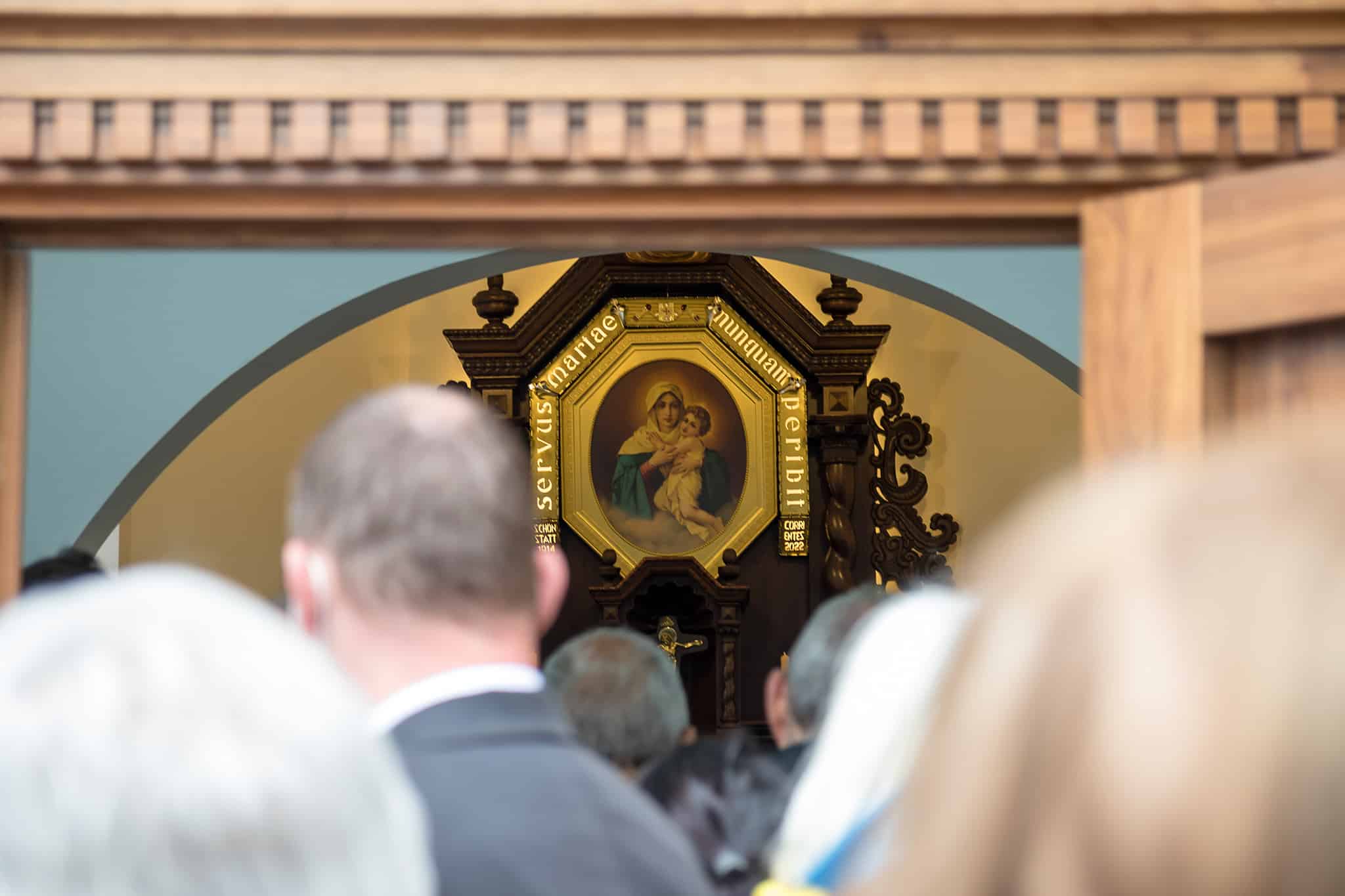
Several Schoenstatt Shrines around the world join in this day of adoration and encounter with the Lord. It is a special opportunity to walk with Christ, preparing for Holy Week.
Everyone is invited to participate and set aside a few moments for adoration, cultivating the bond with Christ and God the Father in a special way during these special days of grace.
Healing the Sick by Healing Relationships - With Mary's eyes!
In this year, Pope Francis dedicated his message for the World Day of the Sick (February 11) to a very special topic for the Schoenstatt Family: attachments. Just as we celebrate the 75th anniversary on May 31st, the Pope invites us to "Healing the Sick by Healing Relationships" - read the full message here.
Sister M. Teresa Olivares, of the Secular Institute of the Schoenstatt Sisters of Mary, is a physician specializing in palliative care. She works in a public hospital in Santiago de Chile, from where she comments on the Pope's message in an interview.
Sister, from your point of view, what does it mean to care for the sick through the Covenant of Love? In other words, how does this bond with the Blessed Mother influence patient care?
I believe that caring for people through the Covenant of Love, in reality, encompasses the whole term "caring" itself. For me it is, in the first place, about being able to look at the person through Mary's eyes. I still remember something when I was studying medicine: there is a moment, of course, when all suffering is very challenging; it makes you wonder about many things. There is also the question: where is God amid all this suffering? I also remember that, in a process of being able to look at what it all meant, I realized that God is in each one of us caring for those who suffer, not only for doctors and health professionals, but for all those who are witnesses, so to speak, to the suffering or pain of the other.
Obviously, Christianity has at its center the care of the most vulnerable and the sick. But I believe that Schoenstatt has as its charism, and at its core, looking at all this suffering with Mary's eyes and heart. That is a different way of looking, it is not better or worse than others, it is simply a different way of looking at it. And that makes a tremendous difference in practical life.
Through that look - which absolutely also applies to [professional] men - we can seek tactfulness, dignity. For example, when uncovering the patient to examine him; determining whether or not it is necessary to uncover him, in cleaning the patient's environment.... Of course, all this applies in the more technical areas as well, that is to say, it is also not just a matter of devoting oneself to these little things and forgetting the reason for being there, which is to implement a treatment, to make a diagnosis. These things, which seem like details, for someone who looks through Mary's eyes, are not details at all.
Also worrying not only about the patient's physical environment, but also about the family, the loved ones, about the social, psychological, and spiritual aspects. It is a way of looking at [the patient] and looking at suffering through Mary's eyes.
And, finally, that look at suffering through Mary's eyes is also that faithful manner of standing at the foot of the Lord's cross, never falling into despair, into absolute pessimism, or into the most terrible nihilism, because it always knows that the Father holds the arms of the cross of his son.
In other words, to have Mary's faith, Mary's heart, Mary's eyes, Mary's hands... that is what we are when we are in front of the other.
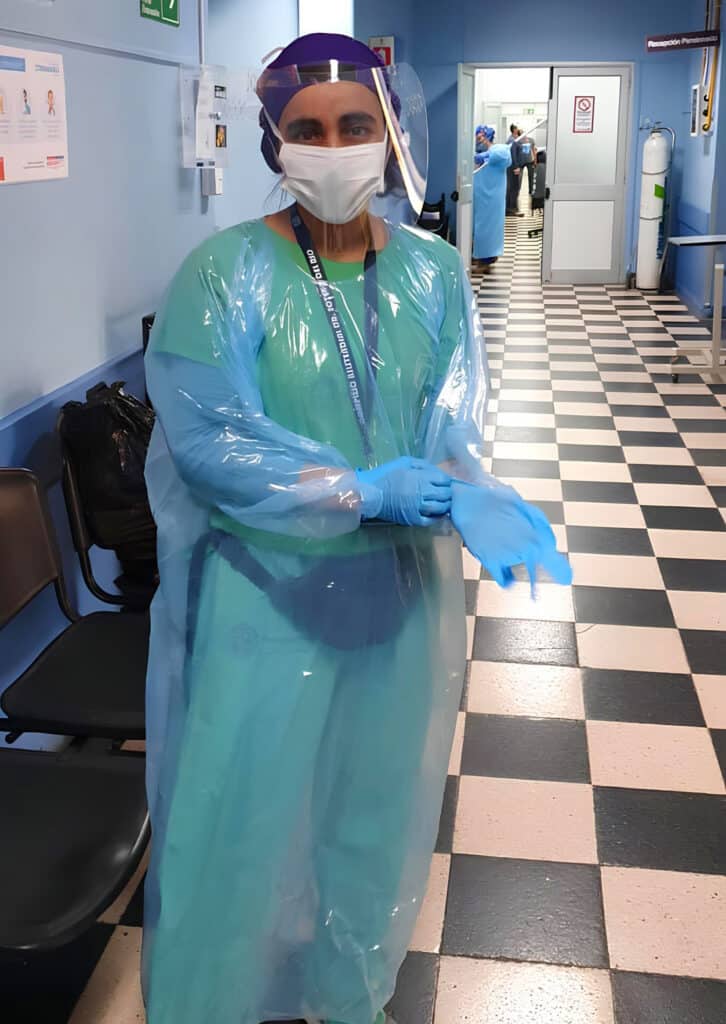
What would you say to those who are going through an illness and to the people who accompany the sick?
I would tell them, first of all, that this is not a punishment, that we should not look for something like "I did wrong in my life so this happened to me". I know that at first one always asks oneself: why is this pain happening to me? Why is this suffering happening to me? What did I do to deserve this? Many questions arise, such as: I took such good care of myself, why did this happen? That I believe, and also from a psychological point of view, does not help much. It doesn't help us to grow and it doesn't help us to cope.
I believe that these two things can help:
- In the first place, this faithful belief in a God who is good, who does not want my affliction, who is not punishing me, but who is actually sustaining me. I think this is one of the first things.
- And, secondly, to understand that an illness, a suffering, always implies a process, a process that is slow, that is not going to happen overnight, but that involves gradual advancement and growth while discovering why things happen.
I was talking to a patient who had a very difficult condition, which compromised her entire intestine, from the mouth to the bottom, and she will never be able to eat again, she will always have to be fed either through a tube directly into the intestine or through intravenous nourishment. And I had to work through a whole process with respect to that. And we started like this: this is it, this is your suffering, you will not be able to eat again, the things that you liked nor those you did not like so much, it's like being in mourning, it's something that has to be done. On the other hand, we have also talked and we are doing everything we can so that she can be fed through other means and continue being nourished. So, the question is, why are we going to do this? There is so much that cannot be done, but there is so much that can be done, so much still to be done for others and so many things that open up in situations like this as well.
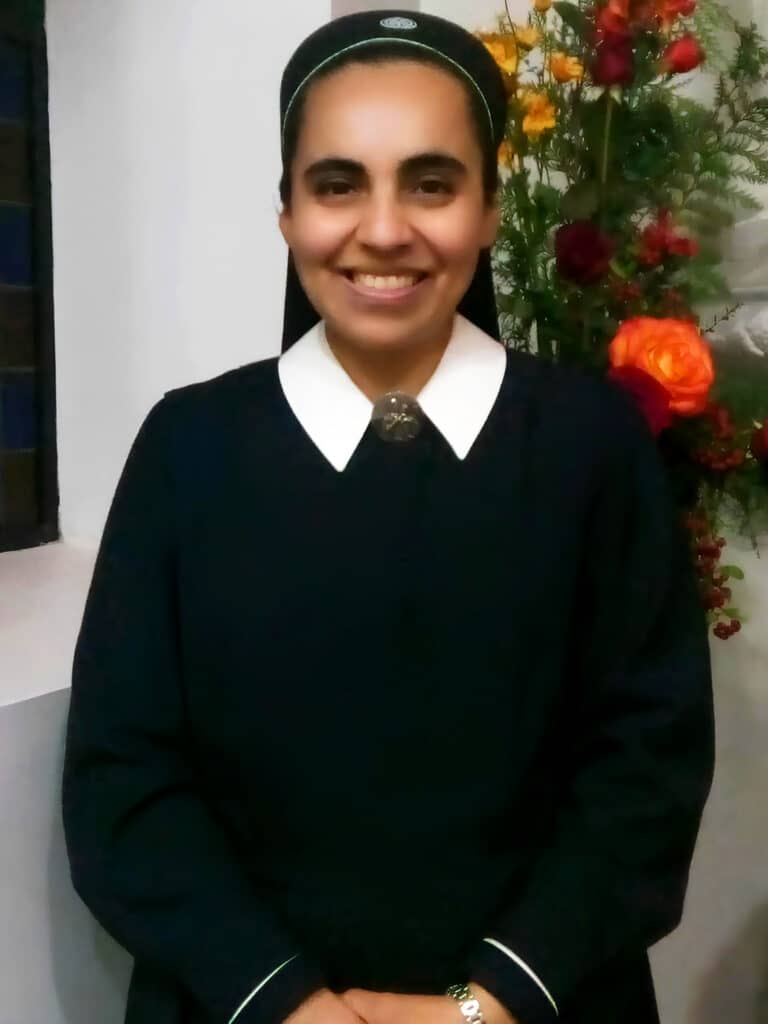
This year, when we celebrate the 75th anniversary of the "31st of May", Pope Francis' message for the World Day of the Sick speaks precisely of attachments. He asks us to care of relationships and writes: "To care for the sick thus means above all to care for their relationships, all of them: with God, with others – family members, friends, healthcare workers – , with creation and with themselves". How do you see this message and what motivation does it bring to the Schoenstatt Family?
One of the most relevant attachments is indeed the attachment to people. And what we celebrate on this May 31st are people as mediators, those who, in the first place, lead us to God, those who allow us to love God with our fully human heart. This is one of the first things and, in this sense, both the sick and those who care for them can feel as that mediator and as that bridge to the heart of God. I, as a vulnerable sick person who requires the care of others, am a bridge so that those who care for me can reach the heart of God - and this is probably my most important task. My care, my vulnerability, my suffering, all this can be a way for others to reach the heart of God and to love God with all their heart. And this involves a lot of humility, I'm not saying it's easy.
I like to think of the world of attachments as a network. We need links with creation, with nature, with people, with things, with ideas, with work... All those links and all those relationships that are relevant to us become a network that offers support to our most authentic, truest self, that which is light in us, that which gives us life and gives life to others. Therefore, we must strengthen all these attachments, in all senses, the way we do in Schoenstatt. And with the warmth of our heart, we also know how to forego, because this is also part of the strengthening of our attachments.
Everything concerning education in human relations and relations with all the things that have been created, strengthens this network that sustains who we are. This is clearly very current, not only in a general way, in relationships with the sick, but in Schoenstatt there is a transcendence and a depth that is rooted in the Covenant of Love and in the Shrine.
For more information about the May 31st Jubilee, click here.
Registration is now open to celebrate the "31st of May" Jubilee in Chile
The Schoenstatt Apostolic Movement in Chile has opened registration for those who wish to participate in the jubilee meeting that will take place in the Bellavista Shrine this year. The event is being held to celebrate the 75th anniversary of the Third Schoenstatt Historical Milestone, which took place on May 31, 1949. See more information here.
Pilgrims from all over the world are invited to take part in this meeting, which takes place at the Cenacle Shrine in Bellavista. This place represents Father Joseph Kentenich's significant step to expand Schoenstatt's mission to the whole Church.
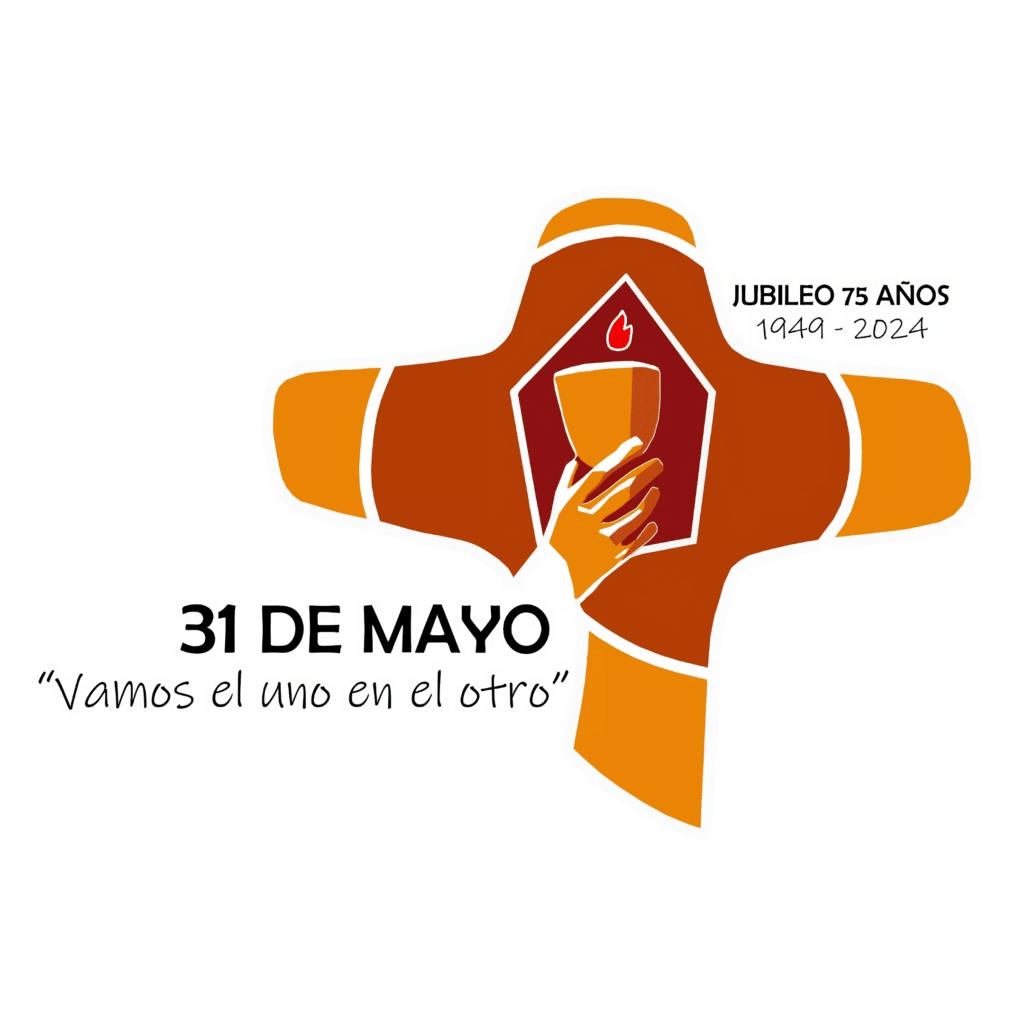
Program
The event takes place from May 31 to June 2, 2024.
Friday, May 31st
Pilgrimage
11:00 - Pilgrimage from Inmaculada San Cristóbal to M. Montt (optional)
13:00 - Pilgrimage from M. Montt to Bellavista (optional)
16:30 - Eucharist: "The place you walk on is holy ground".
19:00 - Vespers and Consecration to the Blessed Mother
20:00 - Dinner and family gathering
Saturday, June 1st
We open our hearts to understand better
9:15 - Introduction: We follow each other
9:45 - Impulse: The charism as a personal experience
12:45 - Lunch and family reunion
15:00 - Cenacle Workshop
17:00 - Eucharist: We drink from the same Spirit
18:00 - Procession and enthronement of the Unity Cross in the Shrine
20:00 - Festival: Grateful memory Salt and yeast
Sunday, June 2nd
We renew the Covenant to be his instruments.
9:00 - Greetings and memories of the previous day
9:30 - Impulse: Schoenstatt, today, here
11:15 - Sending Mass: You are the salt of the earth
12:30 - Covenant Renewal, procession and Angelus
Sign up
Registration is now open, with a special rate for young people. There are also guidelines and suggestions for accommodation on the website - places at the retreat house and those offered by members of the Movement are limited, so keep an eye out; you can also look for alternative forms of accommodation in hotels, hostels, and other options.
To register, click on the button:
Other information
On the new site, you can also find the preparation materials for the Jubilee, details about talks, the pilgrim's kit, and much more.
To access the new website visit: jubileo31demayo.schoenstatt.cl
Mary, make us like you: a "yes" to consecrated life in Schoenstatt
"Show everyone that you follow Christ and put his Gospel into practice, filling your heart with happiness. Infect those who are near you with this joy; and then many people will ask you for the reason and feel the desire to share with you your splendid and enthusing Gospel adventure”[1]. This advice by Pope Francis, addressed to all consecrated persons, was lived with enthusiasm by nine young women from three continents at an international celebration held in Schoenstatt, Germany, this weekend. On January the 27th they gave their "yes" to God, paving the way for the beginning of their novitiate in the Secular Institute of the Schoenstatt Sisters of Mary.
The new Sisters come from six countries: Andrea González from Mexico, Catalina Duggan and María Elina San Román from Argentina, Estrella Almada and María Belén Gómez from Paraguay, Verónica Rina from Spain, Małgorzata Andrzejkowicz from Poland, Christy John and Margreate Anthony from India.
The heart exults with joy
As is customary in the community, at the beginning of the celebration the young women lined up in their white dresses and veils. With joy and great expectation, they enter the large Adoration Church, where many family members and friends are waiting for them.
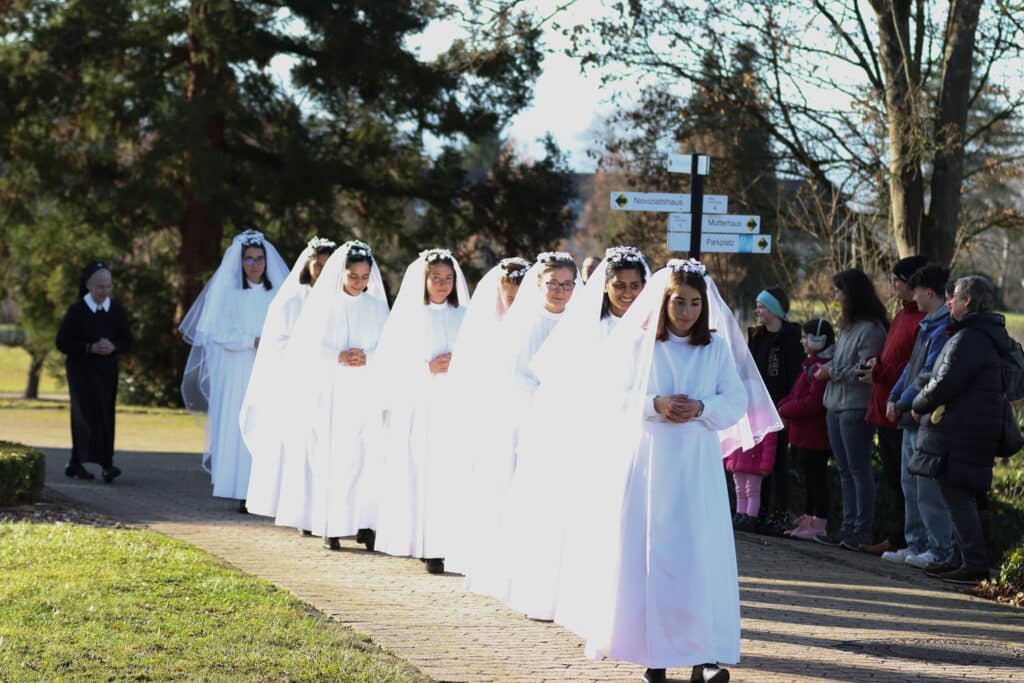
Catherine Duggan tells us about her vocation: "As soon as I let myself fall into God's arms, I felt an inner peace and calmness that I had never felt before. Today, after many difficulties and a long time waiting, I can say that I have received much more than I have given, and I could not be more grateful".
Mary, make us like your image
The Eucharist was presided over by the Director General of the Sisters of Mary, Father Dr. Bernd Biberger. During the solemnity, the young women received their community vestments.
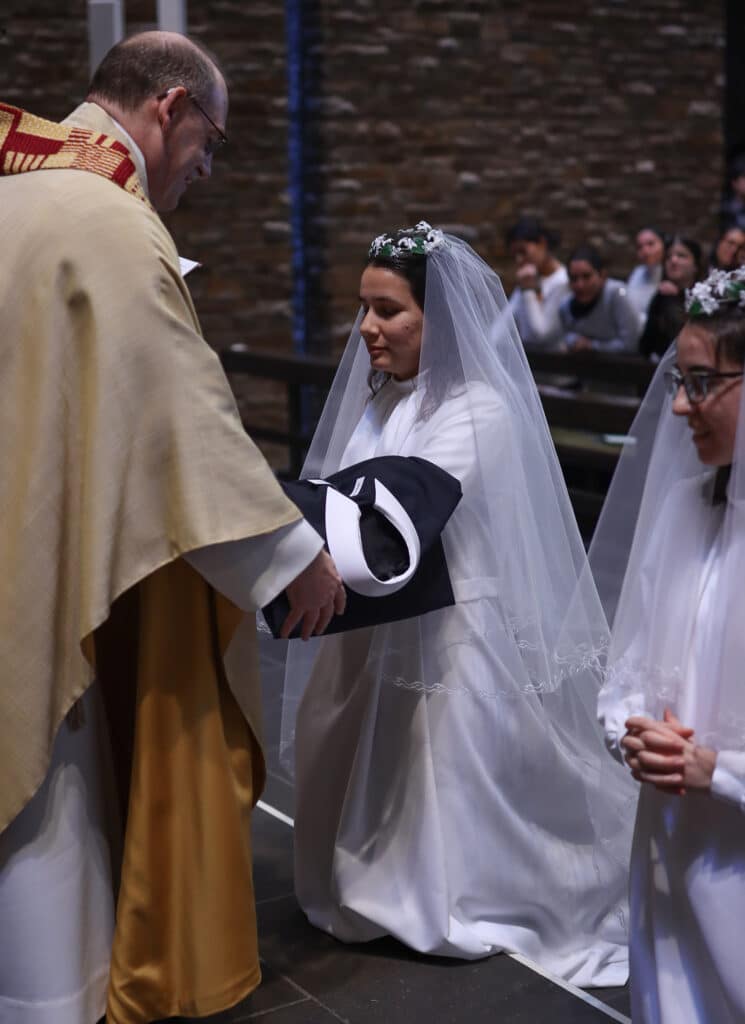
Biberger explained in his homily: "Today the novices will receive the Sister's dress. It expresses their vocation, to make Mary present in this world through themselves. Each Sister has the task of pointing to Mary. In the encounter with them, people should be able to experience something of Mary. This is only possible if every Sister strives to become like Mary, as today's motto expresses it, becoming like her image".
The great desire of the young women from now on is to be a living image of the MTA for the world. Biberger compares this desire to the representations of the Mother of God made through works of art over the centuries. He says: "In asking today for the dress of a Schoenstatt Sister of Mary, the young women express their desire to also experience something of Mary in themselves. Thus, they ask for the grace to resemble the image of Mary, not as a cheap copy but in a totally original, individual way. Each one of them must make visible something of Mary according to her own, original way, defined by her personality".
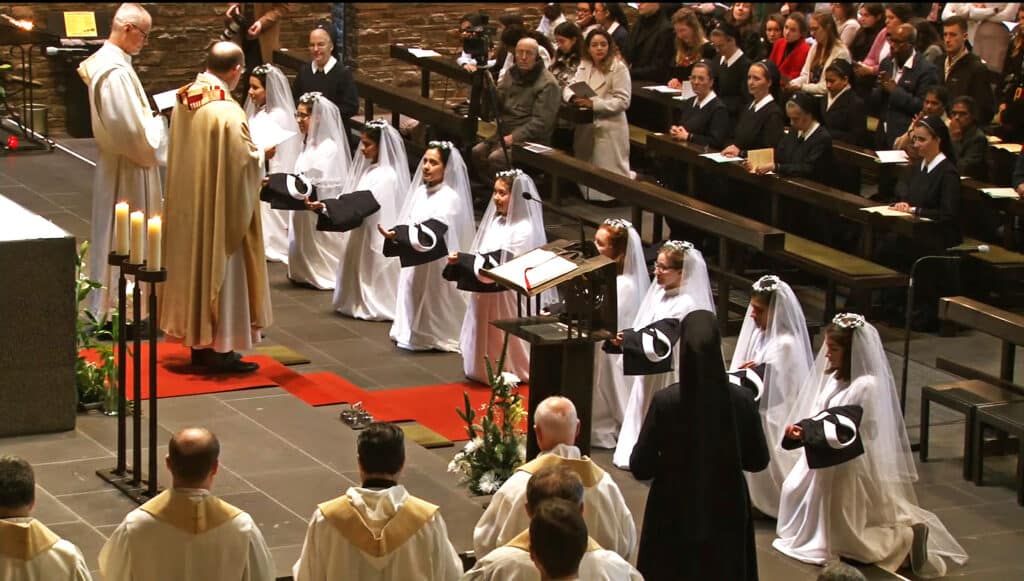
Where there are those who are consecrated, there is joy
During the celebration, the novices leave the church for a few moments to put on their new vestments. Meanwhile, friends and family remain in deep prayer, praying for their vocation.
The moment of welcoming back the young women elicits deep emotional feelings and tears in many. They are presented with their new names for their consecrated life: Sister M. Rafaela, Mexico; Sister Maria Elina, Argentina; Sister Christy Maria, India; Sister Estrella Maria, Paraguay; Sister M. Małgorzata, Poland; Sister M. Consuelo, Argentina; Sister M. Margreate, India; Sister Maria Belen, Paraguay; Sister M. Veronica, Spain.
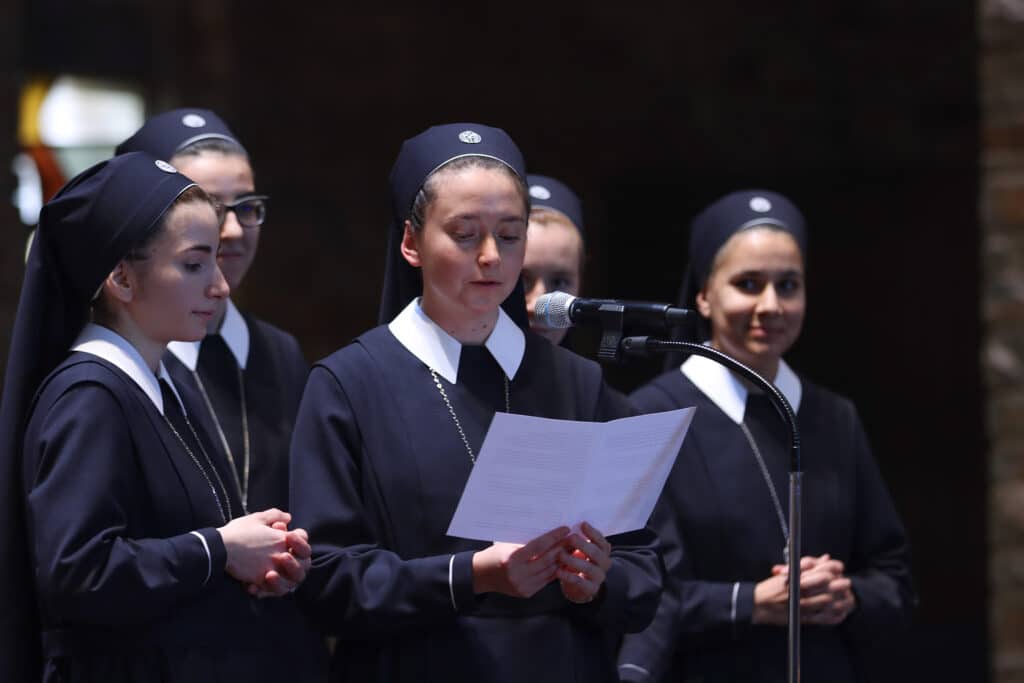
Now called Sister Maria Elina, a young woman from Argentina, says: "When we want to live a life with God, our life becomes a continuous conversation with Him.... our life becomes prayer. He asks, I answer, He proposes, I dispose, I ask, He answers me, I rejoice and so does He... He speaks through my affinities, desires, the problems that arise, the talents He has given me and also through my difficulties.... Thus, we walk together and that's how I know what and how to respond to what happens in my life."
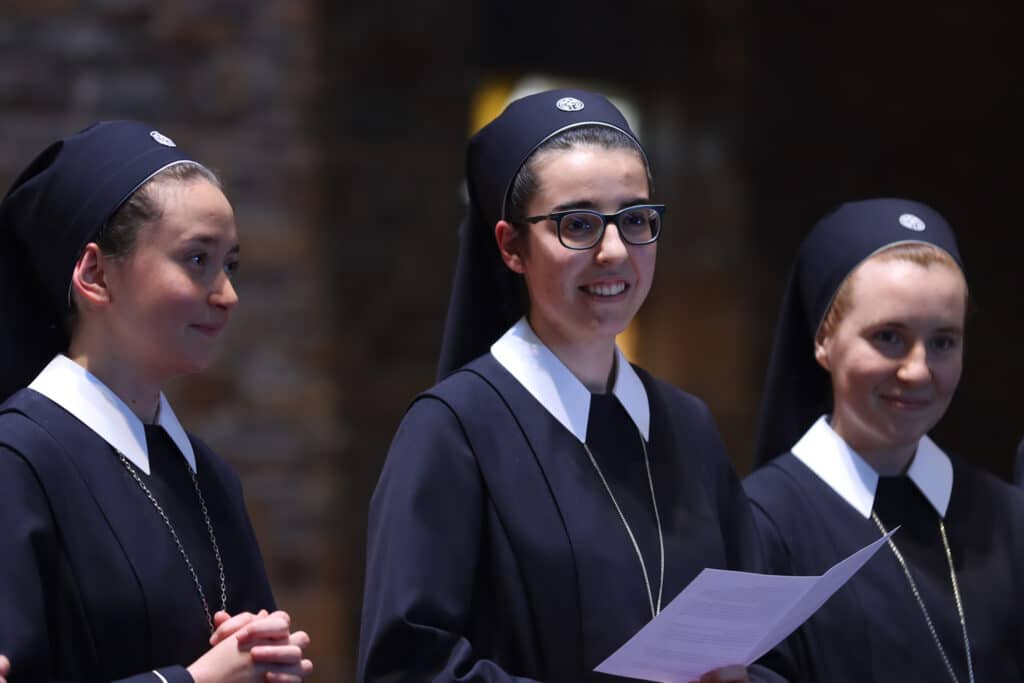
The investiture ceremony was broadcast live and followed by people from several countries. Javier Fuentes writes: "Many Congratulations to all our Sisters, we send you a warm embrace from Leon, Mexico." Ania Bartczak writes in Polish: "Thank you for your beautiful testimony and beautiful celebration. Blessings to all the Sisters.
Watch the full video:
"Where there are those who are consecrated, there is joy," says Pope Francis. And it is with joy that the new novices embark on this journey of surrender, love, and commitment, which has only just begun, towards a future of self-giving and love.
[1] FRANCIS, Pope. Message of His Holiness Pope Francis for the opening of the Year of Consecrated Life. Sunday, 30 November 2014.
9 young women declare their "yes" in the community of the Sisters of Mary
22-year-old Andrea Gonzalez, a young Mexican woman, was going about her normal life - studying, making friends, taking part in activities... - when the inevitable and fundamental questions were raised:
- Where do I want to be in 10 years?
- Who do I want to be in the future?
- What legacy do I want to leave in this world?
- What will people say about me if I am no longer here tomorrow?
She remembers: "Some of these questions are on a waiting list, kind of like what happens with a playlist of songs we create on Spotify. Sometimes we jump to the next question, leaving some behind, or wanting to click 'remove Ads', like we do with YouTube ads."
However, it's impossible to skip these answers forever. So, with courage and an open mind, she decided to listen to what God wanted for her life.
9 young women say "yes" to a consecrated life as Sisters of Mary
Andrea is one of nine young women who will say "yes" to a consecrated life as part of the Secular Institute of the Schoenstatt Sisters of Mary this Saturday, January 27, 2024.
The ceremony will take place in the Adoration Church in Schoenstatt, Germany.
During the Solemnity of the Investiture, they will receive the dress of a Schoenstatt Sister of Mary. In the invitation they write a prayer from Father Kentenich addressed to the Blessed Mother: "Mary, make us likenesses of your image".
Who are the future novices?
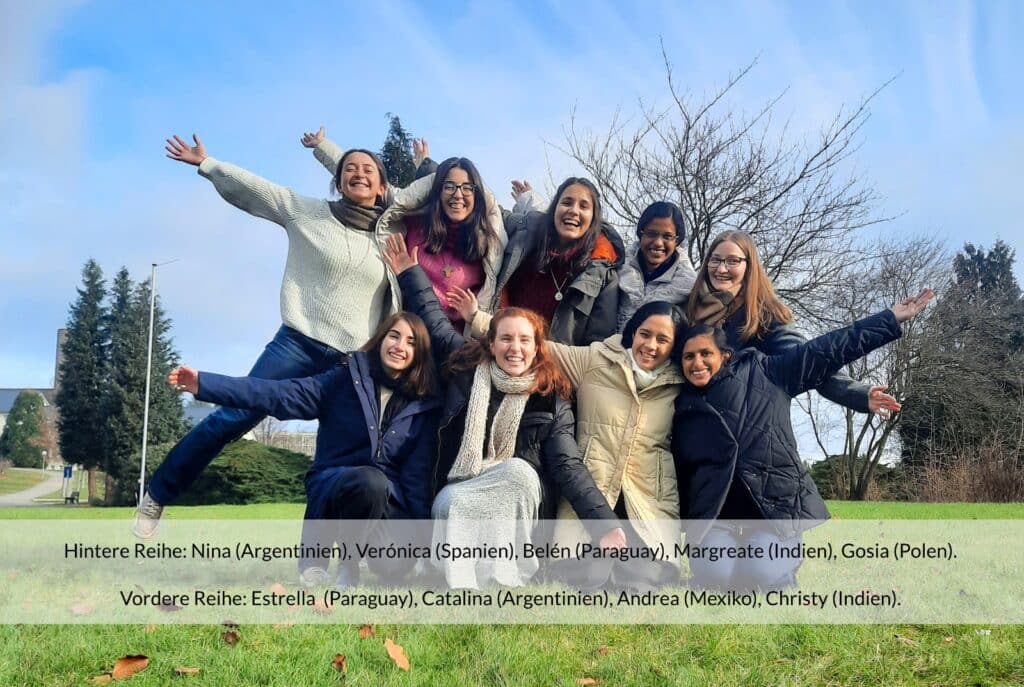
The young women come from six countries:
Andrea González Valdez, from Mexico (read her testimony)
Catalina Sofia Duggan, from Argentina (read her testimony)
Christy John, from India
Estrella María Ortellado Almada, from Paraguay (read her testimony)
Małgorzata Renata Andrzejkowicz, from Poland (read her testimony)
Margreate Anthony, from India
María Belén Gómez González, from Paraguay (read her testimony)
María Elina San Román, from Argentina (read her testimony)
Verónica Rina García, from Spain (read her testimony)
A game of hide and seek
Belén, a 28-year-old Paraguayan speech therapist, tells us: "In the last years of college, different questions began to pop up regarding my future life. At first, they were related to the career I was finishing, but one question led to another and so I came to a central one: What did God want or what did God have in mind for my life? Answering this question took me a long time. God was knocking on the door of my heart and I, time and time again, was ignoring Him. It was like playing hide-and-seek."
When clarity came to her about her vocation to consecrated life, Bélen knew what to do: "When I discovered that God's Will for me was that I consecrate my life to Him, I had no doubt that it was in the community of the Sisters of Mary. In them I can see how each one embodies Mary with her own authenticity and thus carries her into the world. I felt peace when I was finally able to utter that monosyllabic word, so simple and short, but so important: Yes".
Being like Mary
Estrella, a 24-year-old Paraguayan engineer, gives us a down-to-earth account of how she discerned her vocation: "I began to write down the moments when I had experienced God's guidance in my life, starting from my childhood. I reviewed my life and went through the experiences, people and places that had left their mark on me. With the help of the Blessed Mother, in prayer, I discovered God's messages in my life, in the small and simple things of my day-to-day life. And so, it became a reality for me, that God has a unique plan of love".
Responding to the vocation, for Estrella, implies a step of childlikeness: "The Blessed Mother taught me to trust and to allow myself to be led by God who is Father...I no longer need to have everything planned, but only to allow myself to be loved so that I can learn to love and to give my Yes. Schoenstatt has given me the gift of discovering that just as I am, in my smallness, I can aspire to resemble the Blessed Mother, a little more each day".
The road in search of a vocation is beautiful
Małgorzata, a 25-year-old Polish woman, says that her "Yes is only a minor response of love to the invitation by a great love."
For young people who are discerning their vocation, she gives three suggestions: "1) Recognize God's will; 2) Accept God's will; 3) Respond to God's will." And she also states, "I hope you have great courage to accept the adventure with God and an open heart to be able to joyfully say 'yes' to his plan of love."
Veronica mentions prayer as one of the keys to discovering one's vocation. And she concludes, "The most important thing on this path is to remain open and do something, not to stay on the couch waiting for God's call, but to pray and show God through your life that you desire the very highest and wish to follow the path He has intended for you. Because whether it is a consecrated life or a married life, our life is for the Lord. The path of seeking a vocation is precious, because God comes to meet you and comes to show you what He has planned for you in, from and for love."

Follow the ceremony of the novices' investiture live
The day of the investiture is unforgettable for the Sisters, because they receive their dress as a Sister of Mary. We hope they have a profound experience on the way to the fulfillment of their personal ideal. Everyone is invited to participate in the ceremony live on the German channel of the Sisters of Mary.
Date: Saturday, January 27
Time: 11 a.m. (local time in Schoenstatt, Germany)
Broadcast: Youtube, channel Schönstätter Marienschwestern
For this day, the young women are counting on your prayers and offerings to the Capital of Grace.
16 Latin American youth live a unique experience in Schoenstatt
16 boys and 2 priests from Latin America have packed their bags and embarked on several special days full of adventure in Schoenstatt, Germany. From December the 27th to January the 28th, the 2024th edition of the International School for Schoenstatt Boys' Youth Leaders is taking place.
Father Afonso Wosny, from Brazil, and Father Claudio Martinez, from Chile, are accompanying the young leaders from seven countries: Argentina, Bolivia, Brazil, Chile, Costa Rica, Mexico, and Paraguay.
Who are the young men?
They are:
From Argentina: Agustín Ossés and Benjamín Álvarez.
From Bolivia: Adrián Bettancourt
From Brazil: Davi Gimenez, Gabriel Lenharo, Nicolas Fachini and Pedro Bastos.
From Chile: Ignacio Villanueva and Victor Leal.
From Costa Rica: David Corrales, Ian Cunningham and Santiago Pontijo.
From Mexico: Bernardo Torreblanca and Sebastián Prado.
And from Paraguay: Diego Aquino and Matías Gómez.
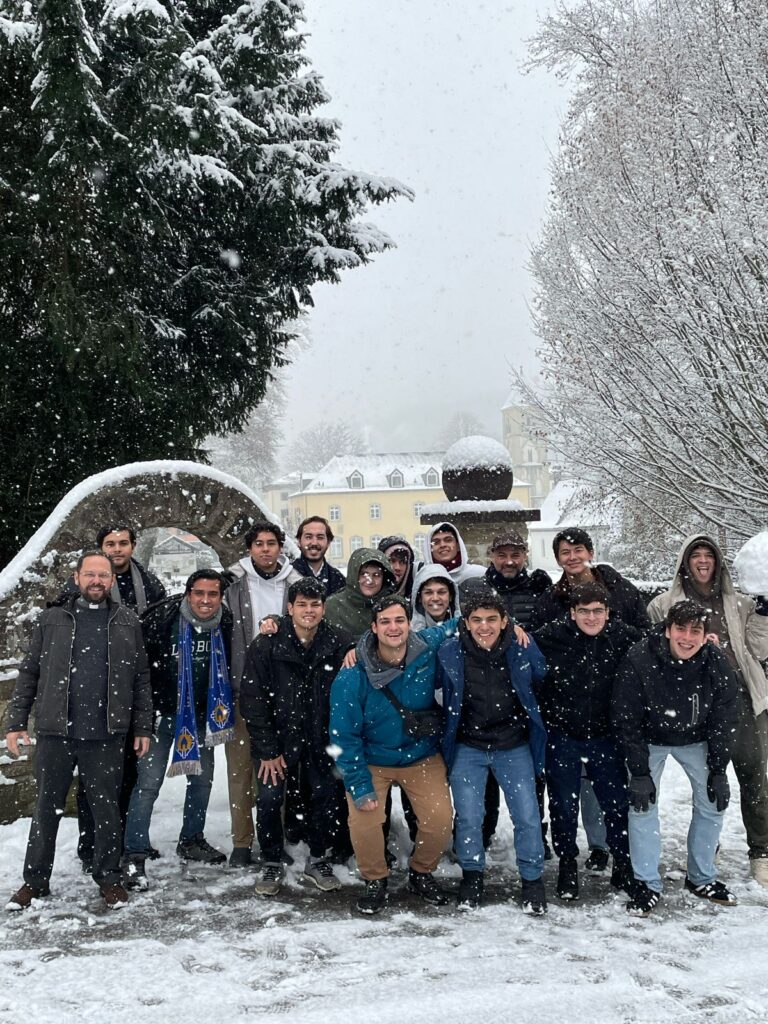
Forging leaders
One of the main objectives of the school is to immerse the participants in Schoenstatt's history. It also aims to develop aspects of leadership and apply Father Kentenich's pedagogy to the leaders' lives.
Ian is the leader of the university students in the western sector of Costa Rica and shares that "this experience in the School of Leaders has been very renewing and inspiring for me, for my bond with Father Kentenich, with the Movement and with all the legacy he has left us. We can live this history in our own flesh, embodied in each of the activities and historical places we visited. It is definitely an experience that influences us as leaders in the best possible way."
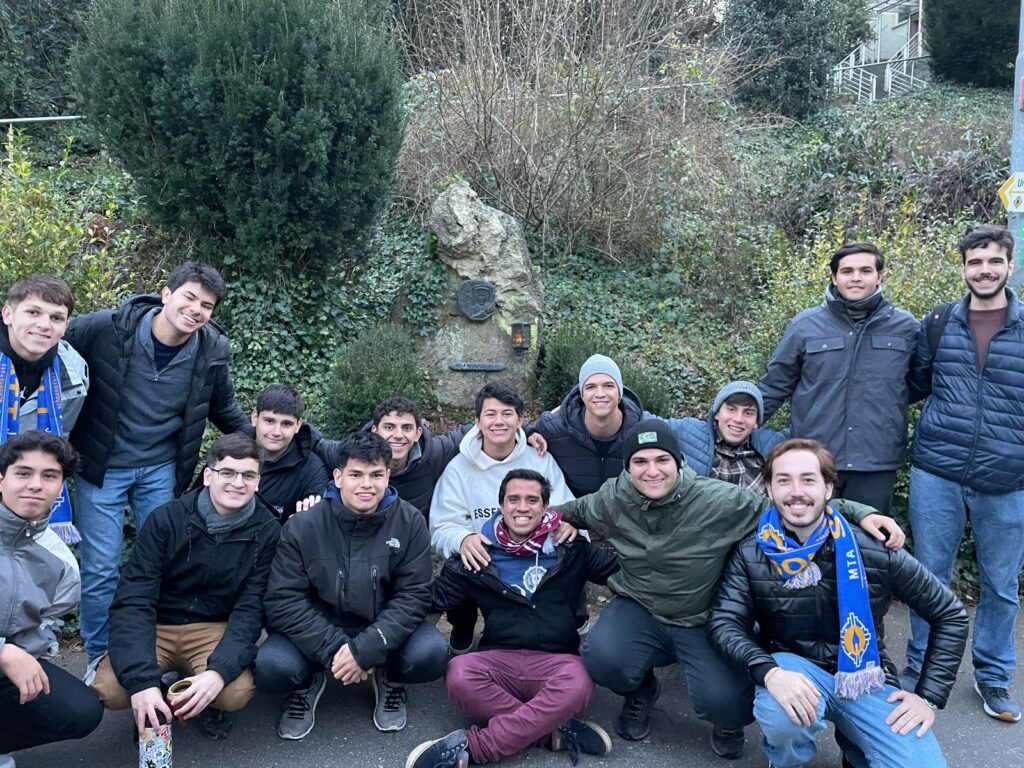
A personal encounter with others
To get to know the Original Shrine, to visit places that have marked Schoenstatt's history, to have contact with representatives of the different communities.... Everything is planned so that they will be special days of unity, joy, and exchanges.
Nicolás, from Brazil, says that these days are truly an encounter: " First of all with the three points of contact, Mary, Father Kentenich and the Shrine, absorbing directly from the source of the charism and learning from the people who lived the history". And not only that. He adds: " Getting to know different cultures and languages opens our hearts to other realities in the world. Besides the international experience, such as the national theme nights and trips to places that mark Schoenstatt's history, we have the spiritual experience with daily Masses, adoration and prayers. The encounter is also personal, the encounter with myself and with others", he closes.
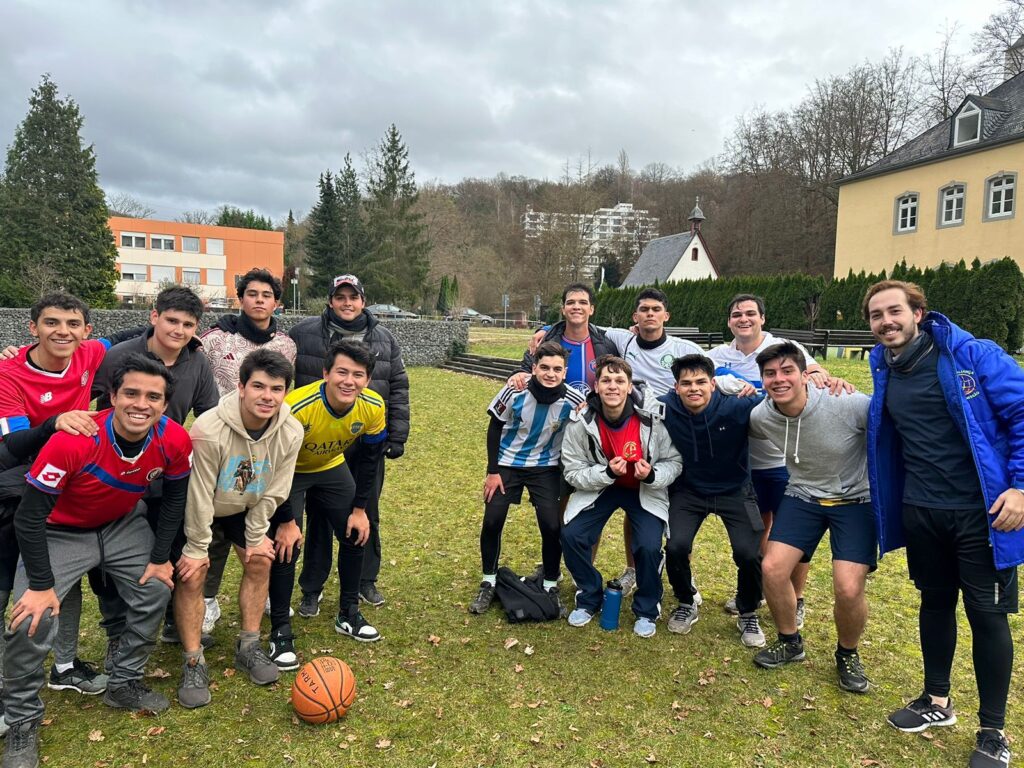
Getting to know the wide universe of Schoenstatt
The youth experienced a snow-white Original Shrine, with cold everywhere, but at the same time, with a warm, welcoming and incomparable atmosphere. In addition to the historic places and the Shrine, they also visited the center of different Schoenstatt communities: the families, the priests, and those who are consecrated...
Bernardo, from Mexico, mentioned that "being here at the School for Leaders is a gift from God, from the Blessed Mother. They are experiences full of friendship, of the Blessed Mother's gifts in every situation. We have been able to learn about and experience many historic moments of Schoenstatt. We also learned about our different branches and what Schoenstatt is from an international perspective. It is an excellent time of personal enrichment, which we want now to transmit to everyone," he remarked.
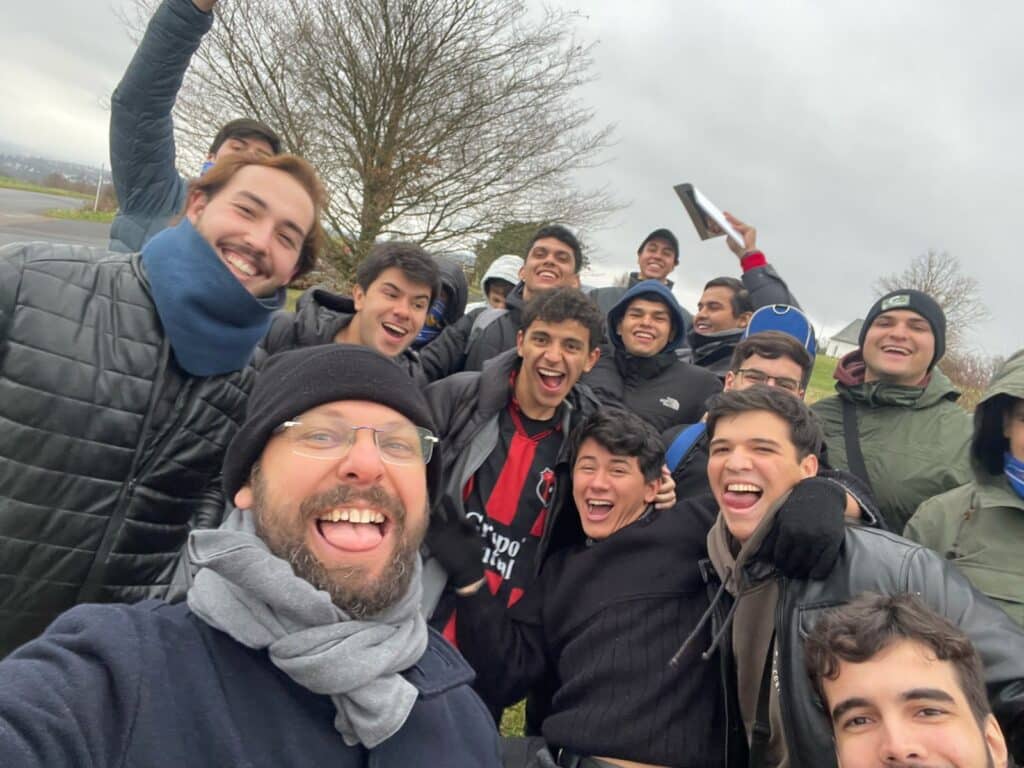
Taking the fire of the Covenant to the world
For Gabriel, from Brazil, it took days before he "realized" that he was really in Schoenstatt. "It doesn't seem like reality to be fulfilling the dream of experiencing the heart of the Movement," he commented. "Something as important as this was, a place as holy as this. It's very hard to imagine actually being here. It's a wonderful thing, a great feeling of happiness, of gratitude, of feeling at home."
The desire of all the youth who experience such special days is to share everything with their friends and mates from the Boys' Youth. "At the beginning, you are a little worried: how to get here, what it is going to be like.... But when you arrive, you know you are at home," Gabriel continues. "When you look at the image of the Blessed Mother, you know that indeed, you are welcome here, that you are sheltered. The school is like the three graces of the Shrine: we leave here transformed, ready to take this to other people, through formation, but much more, through our attitudes. May our attitudes be motivated by this place, by the many heroes who passed through here. It is very satisfying, very remarkable. It is also an honor to be able to take this to other people," he concludes.
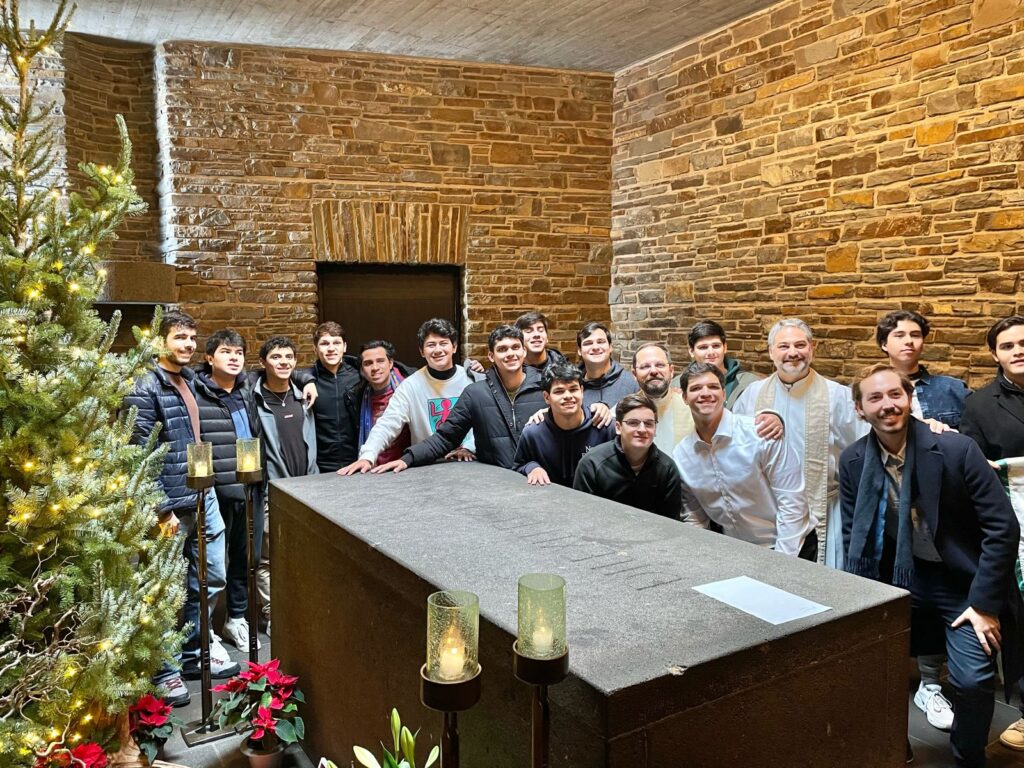
Switzerland has a married couple as leaders of the Movement for the first time
At their meeting last November 15th in Quarten, the members of the National Presidium of the Swiss Schoenstatt Movement elected Rita and Franz Schuler as the new National Directors of the Movement in Switzerland. They will succeed Father Raffael Rieger, Schoenstatt Father, on January 1st, 2024. Their term of office is for six years. The Schulers are the first couple to become leaders of the Schoenstatt Movement in Switzerland.
The Schulers belong to the Swiss Schoenstatt Family Federation. They commented that they are "the first couple in Switzerland to undertake the leadership of the Movement. We completely place ourselves at the disposal of the Movement's League as those responsible for the Movement. Regarding the challenge, for the time being, we do not know exactly what awaits us. We are counting on the support of the Central Office in our task. This comprises sisters, priests, and other active people in the various branches. At this time, we have around 13 people".
What is the role of a Movement Director?
The task of the Movement Director is to create networks and build bridges. He/she establishes networks between the independent branches of the communities within the Schoenstatt League. The head of the Movement is responsible, among other things, for the annual delegates' meeting. In addition, he/she oversees and administers the National Central Committee. There, those who render services in the branches of the League and who are active in spiritual care meet. Together with the National Presidium, the National Directors of the Movement represent Schoenstatt to the outside world. More information here.
The challenge of building a promising future together
The couple spoke about their expectations: "Under the guidance and assistance of our dear Blessed Mother, we want to lead the Swiss Schoenstatt Family into the future. In this task, we will rely on the help of many, on everyone's support, each one in their own place and each one with their own possibilities. One of our goals is to be attentive to the diversity of the Schoenstatt Movement in Switzerland, to perceive where there is growth, where something is on fire, and where support is needed. We also see networking and growing together as a central aspect of our task."
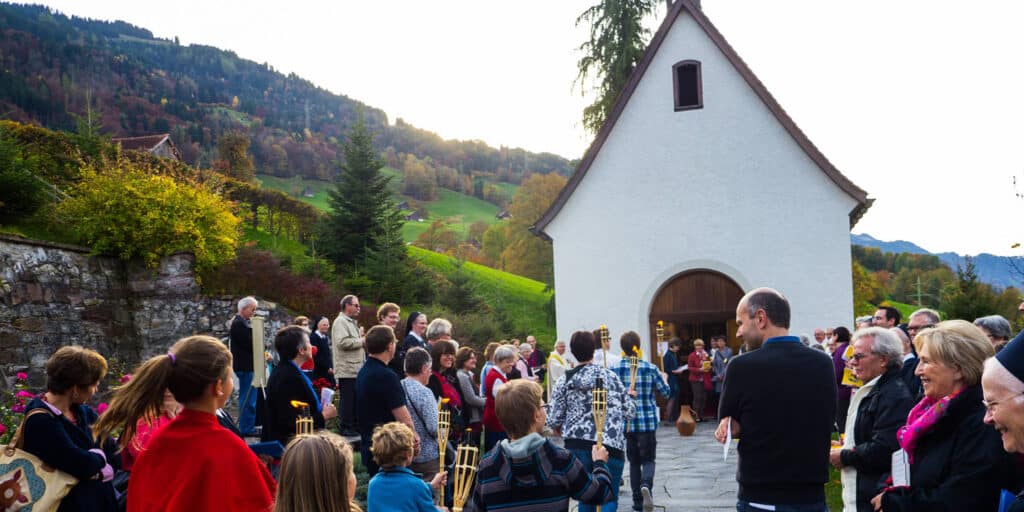
Message from the National Presidium
The members of the National Presidium cordially thank Rita and Franz for their willingness to take on this task and thus lead and accompany the Swiss Schoenstatt Movement into a new phase. In the official letter, the Presidium expresses:
"It is important for the National Presidium and also for Rita and Franz Schuler to be supported in this task. As a next step, they will look for "advisors and collaborators" with whom they would like to fulfill this task.
We warmly congratulate Rita and Franz on being chosen and ask God's blessing and His Holy Spirit of wisdom for this task. Thank you for all your prayers so that we can continue on a successful path towards the future of the Schoenstatt Movement in Switzerland".
Finally, the new leaders of the Movement state: "Together, we want to constantly rethink and redefine the vision of Father Joseph Kentenich, wherever we are."
An encounter between brothers: A visit to the Motherhouse of the Pallottine Fathers
The International Presidium of the Schoenstatt Movement visited the Generalate of the Society of the Catholic Apostolate - the Pallottine Family - in Rome. The meeting took place on November 8th during the conference of the Presidium.
Together they took part in the Eucharistic celebration and in a time of exchange. Fr. Alexandre Awi Mello, President of the General Presidium of the Schoenstatt Movement, recalled that there have already been other visits by Schoenstatt representatives to the Pallottines: "It is an encounter that has already taken place on other occasions. We participated in Holy Mass and in a moment of prayer; we had dinner together with the members of the Pallottine government. It is a visit from friends, from brothers, so that we can keep this contact alive," he explained.
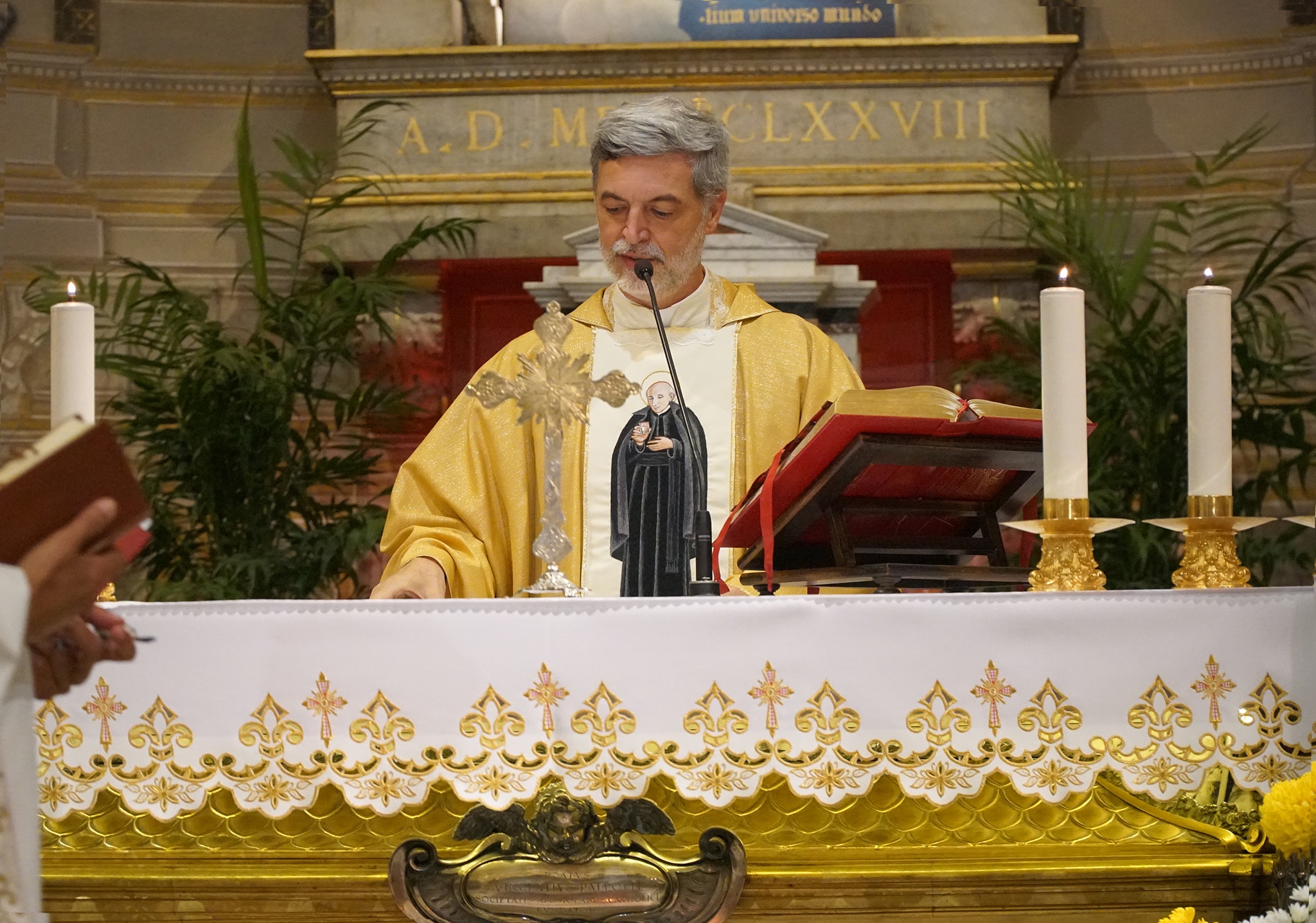
As brothers before the altar
The Holy Mass was celebrated by Fr. Alexandre at the altar where the body of St. Vincent Pallotti rests. At the beginning of the celebration, Father Jacob Nampudakam, President of the SAC (Society of the Catholic Apostolate), welcomed the members of the Schoenstatt Family, also on behalf of the Rector General, Father Zenon Hanas, who was in Rome. Fr. Jacob recalled that it was St. Vincent Pallotti who brought the two spiritual families together for this moment of celebration, whose spiritual and apostolic ideals are shared by both communities.
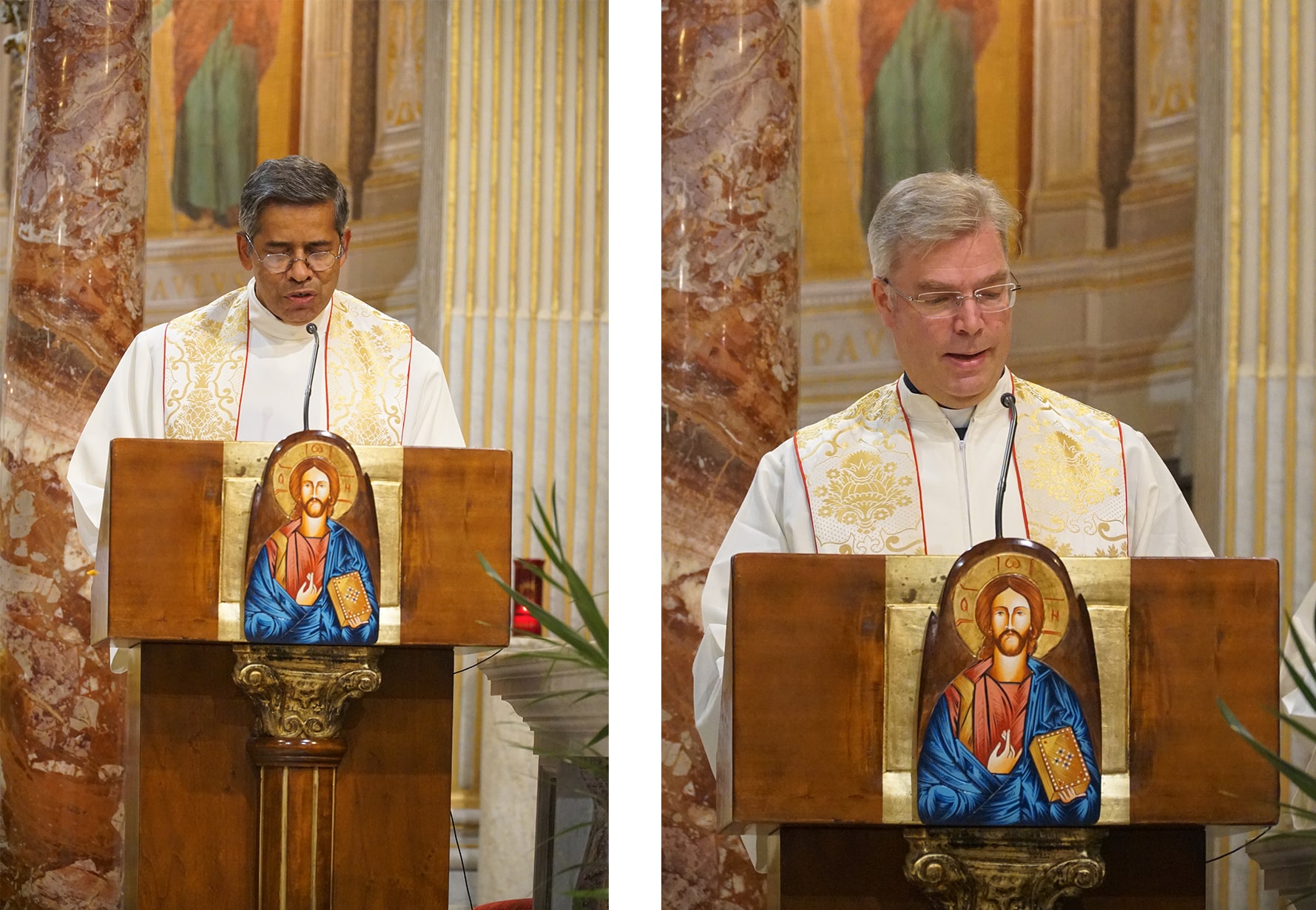
Both Father Alexandre Awi Mello and Dr. Christian Löhr, Rector General of the Schoenstatt Institute of Diocesan Priests, expressed their joy at the privilege to celebrate Holy Mass at the altar of St. Vincent Pallotti. Both expressed their gratitude for the spiritual and apostolic heritage that they were able to share with the Pallottine Family.
"It was an extraordinary experience for me to experience the welcome and joy of the Pallottine community to meet with members of the Schoenstatt Movement this afternoon. I also realized again how important the common root of the two works of evangelization is in the person of St. Vincent Pallotti. I am certain that with our charisms we can make a very concrete contribution to solving the current problems of our Church today. This meeting was synodality in action," said Sr. M. Cacilda Becker of the International Schoenstatt Coordination, recalling a theme that was highlighted during the meeting.
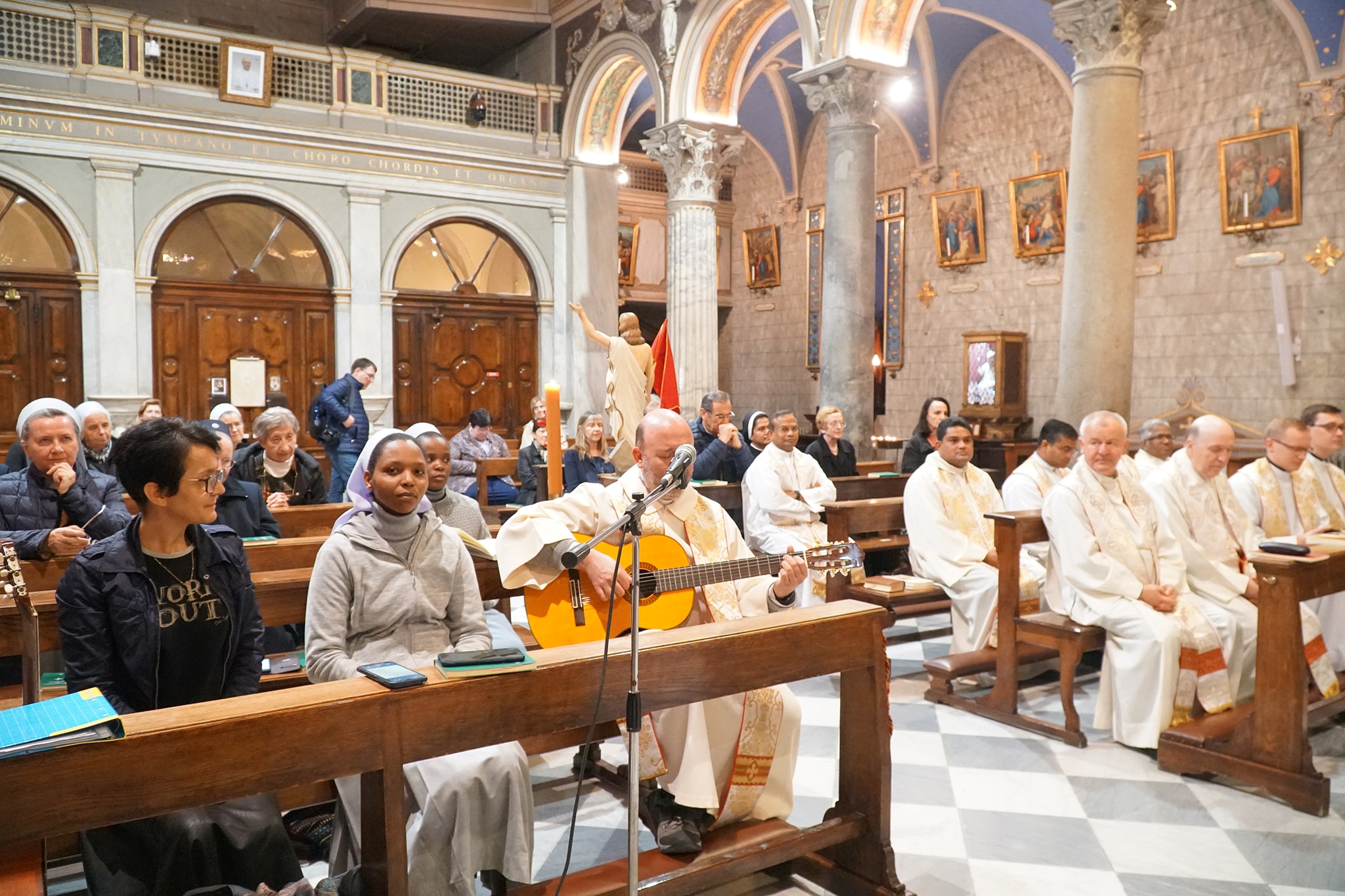
Serenade in the Original Shrine for the opening of the novena 2023
On October 9, the novena in preparation for Covenant of Love Day 2023 will begin. This year it will be inaugurated with a special presentation in Schoenstatt's Original Shrine: the "Serenade for Mary", performed by Brazilian singer Ziza Fernandes.
She will begin her performance at 8:00 p.m. (local time), and it will be broadcast live by Schoenstatt TV and via the cameras at the Original Shrine.
Who is Ziza Fernandes?
The Brazilian singer has a 30-year career as a composer and singer, with dozens of national and international albums, books, DVDs, and courses. In 2013 she was the musical director of the WYD in Rio de Janeiro, coordinating all the official performances of this mega-event. In addition to Portuguese, Ziza speaks French, Italian, English, and Spanish, has a master's degree in psychology and is a music therapist, teacher, entrepreneur and writer.

In Brazil, the singer became acquainted with some of the Schoenstatt Shrines in Paraná, her native state, and São Paulo, and, on a tour through Germany, she visited the Original Shrine. She then received an invitation from the rector of the Shrine, Father Ignacio Camacho, to perform this serenade, which she gladly accepted and now says: "in the Original Shrine is a grace that goes beyond me, it is an experience that marks my history. My intention with this serenade is to honor our Mother with as much beauty as I can provide. I will play alone, with a guitar and tracks, and I want to give myself to the fullest”.
The novena for October 18
The novena will continue throughout the days, always during the evening blessing at 7:50 p.m. in Germany. The transmission will take place live through the webcam at the Original Shrine - Click here.
The text of the novena will be sent to WhatsApp groups, corresponding to the different languages. To join, choose the language in which you wish to receive it:

